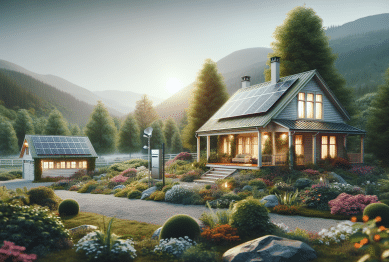Curious about creating a stunning outdoor retreat without the backbreaking upkeep? Explore how low-maintenance gardening can bring vibrant color, relaxation, and sustainability right outside your door. Learn to select durable plants, design for efficiency, and transform your landscape into an inviting, stress-free refuge.
Embracing Low-Maintenance Gardening
Low-maintenance gardening is a practical approach for anyone who loves beautiful landscapes and minimal chores. The concept centers around easy-care plants, smart design, and efficient techniques that significantly reduce the usual demands of weeding or constant watering. By choosing native plants and drought-tolerant varieties, outdoor spaces can thrive on less, providing year-round appeal without excessive intervention. This method not only frees up time for relaxation but also supports pollinators and encourages local biodiversity, creating a thriving ecosystem right at home. For many, the idea is both liberating and inspiring, offering new ways to enjoy outdoor living without sacrificing style. A well-designed low-maintenance garden can reflect your taste and lifestyle while promoting sustainability and reducing water consumption—a win for you and the environment.
Getting started requires a shift in mindset. Rather than constantly battling nature, low-maintenance gardeners work with it. This involves observing local climate and soil conditions to make informed plant selections and incorporating hardy groundcovers that naturally suppress weeds. Clever use of hardscapes, such as gravel paths or decorative mulch, reduces open soil and minimizes tasks like mowing or edging. Raised garden beds and defined planting zones further simplify upkeep, creating structured beauty even in small spaces. The benefits are tangible: less water, fewer chemicals, and decreased maintenance costs. Families, busy professionals, and retirees all appreciate the freedom that comes with a sustainable, self-sufficient yard.
Many enthusiasts find the process personally rewarding. Watching resilient plants flourish with little intervention is incredibly satisfying. It’s also budget-friendly over time—fewer replacements, less need for fertilizers, and reduced utility bills for watering. Those new to gardening can gain confidence knowing that beginner-friendly options—like ornamental grasses or evergreen shrubs—require minimal knowledge and can survive occasional neglect. Transitioning to low-maintenance landscaping can be gradual or immediate, depending on the current garden setup, but even small changes, like introducing native plants or replacing thirsty lawns, quickly show results.
Choosing Easy-Care Plants for Every Climate
Plant selection is the heart of a successful low-maintenance garden. Native plants are especially valuable since they’re adapted to local weather and soil, resulting in fewer pest problems and less supplemental watering (Source: https://www.epa.gov/greenacres/native-plants-overview). Ornamental grasses, like blue fescue or switchgrass, offer billowing texture without frequent trimming. Perennials such as coneflowers, daylilies, and hostas provide long-lasting blooms with minimal care. Succulents and drought-tolerant species like lavender or sedum are also favorites, thriving in sunny spots where water can be scarce. By mixing foliage shapes, heights, and colors, a garden remains interesting year-round—even as some plants cycle in and out of bloom. Each climate zone offers unique, resilient choices. Consulting a local extension service can reveal what naturally thrives in the area, taking much of the guesswork out of selection. Growing what is suited to your ecosystem ensures reliable results and a healthier outdoor environment.
Evergreen shrubs are the workhorses of easy-care gardens. Boxwood, holly, and juniper hold their shape and color in every season. When layered in beds or alongside walkways, they anchor a design and reduce the need for seasonal replanting. Mixing evergreen with fast-spreading groundcovers like creeping thyme can keep soil covered, prevent weeds, and limit maintenance across borders. In regions with harsh winters, select plants with proven hardiness. In warmer climates, Mediterranean varieties, Australian natives, or desert succulents deliver lush results with little input. Understanding your zone’s possibilities expands creative choices and leads to a landscape that looks vibrant through wind, heat, or cold.
Choosing plants is also about minimizing ongoing costs and environmental impact. For example, trading annual bedding plants—which need replanting every year—for tough perennials ensures lasting color. Wildflowers, ornamental sedges, and low-water ferns are excellent for shady patches. Rain gardens using deep-rooted natives manage runoff while creating wildlife havens. By matching plants to sites—sunny slopes, damp low areas, or dry corners—gardens practically take care of themselves. Over time, these smart choices create a landscape that’s beautiful, economical, and ecologically beneficial.
Intelligent Garden Layouts That Save Time
Design is key to lowering maintenance. Organizing spaces around function lets you focus your energy where it matters while letting other areas remain nearly self-sufficient. Zoning—the process of grouping plants by water needs, sunlight, or height—creates natural order and reduces mismatched care. Sun-loving, water-thrifty plants can be clustered in the hottest, driest part of the yard, while moisture-loving varieties thrive where rain collects. Mulch-filled pathways or patios cut back weeding and watering, offering attractive transitions between lush beds or vegetable plots. Strategic planning also helps avoid crowding, reducing the need to prune or thin as plants mature. Incorporating features like rock gardens, gravel beds, or container clusters reduces lawn area and keeps landscapes easy to manage. Each element should serve a dual purpose—providing aesthetic appeal while functioning to conserve water, suppress weeds, or improve accessibility. Benches placed among hardy plantings offer spots to relax and enjoy the rewards of a truly low-maintenance outdoor retreat.
Another high-impact layout idea is the use of hardscaping. Patios, stone walks, or wooden decks reduce the amount of grass or open ground that demands attention. These features don’t just cut down on mowing; they offer durable spaces for entertaining, dining, or unwinding outside. Raised beds bring gardens up to an accessible height, making planting and weeding easier and limiting soil compaction. Edging defines borders, preventing grass from creeping into beds and keeping lines crisp. With a clear plan, even small or oddly shaped yards can become efficient, tidy, and visually striking.
When planning, it’s crucial to anticipate maintenance challenges before they arise. Placing rain barrels or irrigation systems near plant-dense zones simplifies watering. Choosing resilient surfaces for paths helps prevent erosion, while proper grading can direct runoff away from sensitive areas. Use of windbreaks—like fences or tall shrubs—protects delicate plants from harsh weather, further reducing problems down the line. A little foresight can prevent hours of corrections later, so good planning not only makes routines easier but extends the lifespan of your landscape features and plantings.
Mulching and Soil Care for Effortless Growth
Mulching is a cornerstone of low-maintenance gardening. It suppresses weeds, retains soil moisture, and insulates plant roots from temperature swings (Source: https://www.gardeningknowhow.com/garden-how-to/info/using-mulch-in-the-garden.htm). Organic mulches—like bark chips, shredded leaves, or straw—enhance soil health as they decompose, adding vital nutrients. This naturally reduces the need for fertilizer and promotes robust plant growth. Mulch also creates an attractive, unified look across beds, minimizing bare spots and giving gardens a professional finish. Reapply mulch each season to keep it fresh and effective. Non-organic options, such as stone or rubber, require less frequent replacement, making them suitable for permanent installations in high-traffic zones or rock gardens. Whichever type is chosen, a thick layer helps keep chores minimal and plants thriving.
Soil health underpins every resilient landscape. Testing soil pH and nutrient levels guides amendments that increase fertility without overreliance on chemical products. Well-structured soil supports deeper root growth, improving drought resistance and lessening watering needs. Incorporating compost or green manure builds microbial activity, creating a living ecosystem below ground. Crop rotation in vegetable beds also prevents nutrient depletion and limits pest buildup, making gardens more productive and low-maintenance. Earthworms, encouraged by organic mulches, naturally aerate soil and break down matter into plant-available forms. Rich, well-cared-for soil sets the stage for success, no matter what’s planted above.
Effortless gardening is also about planning for the future. Automating watering with drip irrigation or soaker hoses provides targeted hydration with minimal waste. These systems work well beneath mulch, reducing evaporation and keeping foliage dry—an important step in preventing disease (Source: https://www.rhs.org.uk/advice/profile?pid=372). Selecting regional compost or locally sourced amendments supports sustainability and enhances plant health. Over time, properly prepared beds fill in, leaving less room for weeds and ensuring a vibrant, low-care landscape.
Water-Wise Strategies for Sustainable Gardens
Water conservation is critical in low-maintenance garden design. Selecting drought-tolerant plants, grouping by water needs, and applying mulch significantly reduce the demand for irrigation (Source: https://wateruseitwisely.com/100-ways-to-conserve/landscape-garden/). Rainwater harvesting through barrels or swales collects natural moisture, cutting down on tap use. Installing efficient drip irrigation delivers water directly to roots, drastically lowering waste. Early-morning or evening watering further reduces evaporation, ensuring plants make the most of each drop. Incorporating these techniques into your design saves both time and resources while creating a more sustainable landscape. Xeriscaping combines many of these methods, providing lush results that fit local climates—no matter how dry. Over time, this approach pays off, reducing water bills and environmental strain.
Soil preparation is vital in water-wise gardening. Amending soil with organic matter improves water retention, holding moisture where roots need it. Slight grading or contouring directs rainfall toward thirsty beds. Tall plants, shrubs, or windbreaks can shield delicate plantings from harsh winds, reducing transpiration and protecting valuable water reserves. Greywater systems—properly installed and maintained—may provide supplemental irrigation for non-edible plantings, stretching limited resources further. Consistent, small adjustments have a big impact on water conservation over a full growing season.
For those in drought-prone areas, water-wise strategies open up endless design possibilities. Rock gardens and dry riverbeds not only require minimal care but also showcase drought-adapted beauty. Replacing lawns with groundcovers, ornamental stones, or artificial turf can cut outdoor water use dramatically while giving spaces a clean, modern look. When combined with smart planting and irrigation, water-wise landscapes bring color, texture, and ecological resilience to any property.
Practical Tips to Keep Maintenance Low Year-Round
Simplicity is the hallmark of low-maintenance gardening. Keep plant groupings tight and use mass plantings for dramatic impact with minimal upkeep. Annual tasks like pruning, deadheading, or dividing can be planned in blocks to streamline the work. Many gardeners keep a flexible schedule—spending more time on gardens in spring or fall, but relaxing during peak summer heat when low-maintenance landscapes require little attention. Maintenance routines are best built around observation. Watch which plants thrive and which struggle, and swap high-need varieties for tougher alternatives as needed. Over time, the balance shifts toward a stable, healthy garden that practically takes care of itself. Good organization—tools close to action, labels on perennials, mulch ready for application—turns necessary chores into quick, efficient routines. Compost bins reduce green waste and supply homegrown fertilizer, further closing the loop on garden care.
Even in low-maintenance setups, some seasonal tasks persist. Removing leaves from hardscapes, checking irrigation lines, or refreshing mulch each spring prepares gardens for the months ahead. Dividing overgrown perennials every few years prevents crowding and helps the garden renew itself. With proper plant selection and design, most busy seasons in the garden pass quickly, freeing up weekends for enjoyment rather than chores. For container gardeners, choosing self-watering pots or drought-resistant plantings increases convenience and success. By constantly tweaking—adding a new mulch now, switching out a high-pruning shrub later—maintenance drops over time without any dramatic overhauls.
Sharing the garden’s work, even if informally, helps lighten the load. Friends, family, or neighbors may exchange cuttings or swap garden ideas, fostering a sense of community. Children can be involved with small watering or weeding chores, learning about nature in the process. By building a landscape that welcomes all and needs little, outdoor spaces become pleasurable extensions of the home rather than ongoing projects. Gardening remains a creative outlet—a hobby, not a burden—when designed with ease in mind.
References
1. U.S. Environmental Protection Agency. (n.d.). Native Plants Overview. Retrieved from https://www.epa.gov/greenacres/native-plants-overview
2. University of California Agriculture & Natural Resources. (n.d.). Water Conservation Tips for California Gardens. Retrieved from https://ucanr.edu/sites/UCCE_LA/files/153190.pdf
3. Gardening Know How. (n.d.). Using Mulch in the Garden. Retrieved from https://www.gardeningknowhow.com/garden-how-to/info/using-mulch-in-the-garden.htm
4. Royal Horticultural Society. (n.d.). Mulching and Watering. Retrieved from https://www.rhs.org.uk/advice/profile?pid=372
5. Water Use It Wisely. (n.d.). 100+ Ways to Conserve Water. Retrieved from https://wateruseitwisely.com/100-ways-to-conserve/landscape-garden/
6. University of Illinois Extension. (n.d.). Low Maintenance Perennial Flowers. Retrieved from https://extension.illinois.edu/blogs/good-growing/2022-02-09-low-maintenance-perennial-flowers









